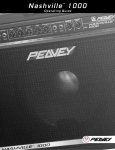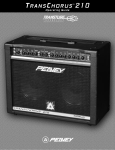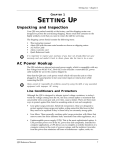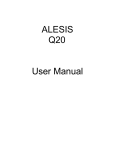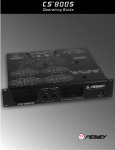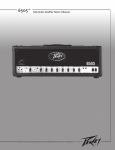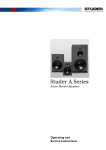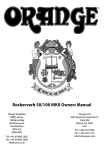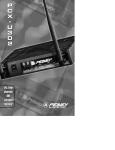Download Audiovox FPE1909DVDC Flat Panel Television User Manual
Transcript
PM ONE P r o d u c t i o n M i xe r Operating Guide ™ Intended to alert the user to the presence of uninsulated “dangerous voltage” within the product’s enclosure that may be of sufficient magnitude to constitute a risk of electric shock to persons. Intended to alert the user of the presence of important operating and maintenance (servicing) instructions in the literature accompanying the product. CAUTION: Risk of electrical shock — DO NOT OPEN! CAUTION: To reduce the risk of electric shock, do not remove cover. No user serviceable parts inside. Refer servicing to qualified service personnel. WARNING: To prevent electrical shock or fire hazard, do not expose this appliance to rain or moisture. Before using this appliance, read the operating guide for further warnings. Este símbolo tiene el propósito, de alertar al usuario de la presencia de “(voltaje) peligroso” sin aislamiento dentro de la caja del producto y que puede tener una magnitud suficiente como para constituir riesgo de descarga eléctrica. Este símbolo tiene el propósito de alertar al usario de la presencia de instruccones importantes sobre la operación y mantenimiento en la información que viene con el producto. PRECAUCION: Riesgo de descarga eléctrica ¡NO ABRIR! PRECAUCION: Para disminuír el riesgo de descarga eléctrica, no abra la cubierta. No hay piezas útiles dentro. Deje todo mantenimiento en manos del personal técnico cualificado. ADVERTENCIA: Para evitar descargas eléctricas o peligro de incendio, no deje expuesto a la lluvia o humedad este aparato Antes de usar este aparato, Iea más advertencias en la guía de operación. Ce symbole est utilisé dans ce manuel pour indiquer à l’utilisateur la présence d’une tension dangereuse pouvant être d’amplitude suffisante pour constituer un risque de choc électrique. Ce symbole est utilisé dans ce manuel pour indiquer à l’utilisateur qu’il ou qu’elle trouvera d’importantes instructions concernant l’utilisation et l’entretien de l’appareil dans le paragraphe signalé. ATTENTION: Risques de choc électrique — NE PAS OUVRIR! ATTENTION: Afin de réduire le risque de choc électrique, ne pas enlever le couvercle. Il ne se trouve à l’intérieur aucune pièce pouvant être reparée par l’utilisateur. Confiez I’entretien et la réparation de l’appareil à un réparateur Peavey agréé. AVERTISSEMENT: Afin de prévenir les risques de décharge électrique ou de feu, n’exposez pas cet appareil à la pluie ou à l’humidité. Avant d’utiliser cet appareil, lisez attentivement les avertissements supplémentaires de ce manuel. Dieses Symbol soll den Anwender vor unisolierten gefährlichen Spannungen innerhalb des Gehäuses warnen, die von Ausreichender Stärke sind, um einen elektrischen Schlag verursachen zu können. Dieses Symbol soll den Benutzer auf wichtige Instruktionen in der Bedienungsanleitung aufmerksam machen, die Handhabung und Wartung des Produkts betreffen. VORSICHT: Risiko — Elektrischer Schlag! Nicht öffnen! VORSICHT: Um das Risiko eines elektrischen Schlages zu vermeiden, nicht die Abdeckung enfernen. Es befinden sich keine Teile darin, die vom Anwender repariert werden könnten. Reparaturen nur von qualifiziertem Fachpersonal durchführen lassen. ACHTUNG: Um einen elektrischen Schlag oder Feuergefahr zu vermeiden, sollte dieses Gerät nicht dem Regen oder Feuchtigkeit ausgesetzt werden. Vor Inbetriebnahme unbedingt die Bedienungsanleitung lesen. 2 PM ONEª Professional Stereo Production Mixer Thank you for purchasing the PM Oneª stereo production mixer. The unique features of this mixer are sure to add to your performances, both live and recorded. The PM One is a true stereo, fully featured mixer with the DJ in mind. With a built-in stereo graphic EQ, stereo level meter, and assignable crossfade, the PM One adds convenience to any production system. This manual combines both a descriptive and tutorial approach in order to explain the function(s) of each feature. Please start at the beginning of the manual, following all safety precautions and warnings. Failure to follow these precautions could jeapardize your safety and the safety of your PM One. PM One Features: Switchable EQ Four Stereo Input Channels One Mic Input Channel Two Stereo Phono Inputs Five Stereo Line Inputs Two Mic Inputs Channel Input Selectors Channel X-Fader 12 VDC Lamp Socket Stereo LED Level Meter Talk Switch Cue Monitor/Assign Stereo Headphone Output Stereo Record Output Stereo Amp Output Stereo/Mono Switch 3 REAR PANEL WARNING: TO REDUCE THE RISK OF 120V 230V 115 60Hz/230V 20 WATTS 50Hz FIRE OR ELECTRIC SHOCK DO NOT EXPOSE THIS EQUIPMENT TO RAIN OR MOISTURE. TO PREVENT THE RISK OF FIRE HAZARD, REPLACE WITH SAME TYPE 250 VOLT FUSE. AVIS: RISQUE DE CHOC ELECTRIQUE NE PAS OUVRIR. REMPLACER PAR UNFUSIBLE DE MEME TYPE ET DE 250 VOLTS. ONE TM OUTPUT PRODUCTION REC MIXER F 500 mA 250V 1 AMP CHANNEL THREE LINE 5 LINE 4 CHANNEL TWO LINE 3 CHANNEL ONE LINE 2 PHONO 2 LINE 1 PHONO 1 GND L L L L L L R R R R R R MIC 2 FUS E FUS E 115V CHANNEL FOUR 4 A PRODUCT OF PEAVEY ELECTRONICS CORP. MERIDIAN MS. 2 5 6 7 8 10 DESCRIPTIONS POWER The PM One is supplied with a switchable power supply. Before plugging your PM One in, please read this entire section to ensure proper supply voltage selection and unit operation. It is important that all safety precautions be followed. 1. VOLTAGE SELECTOR SWITCH Use this switch to select the proper AC supply voltage for your area. This voltage varies from one geographical area to another. For voltages between 110 and 120 VAC, select the 115 position. For voltages between 220 and 230 VAC, select the 230 position. 2. IEC POWER CORD This receptacle is for the IEC line cord (included), which provides AC power to the unit. Connect the line cord to this connector and to a properly grounded AC supply. Damage to the equipment may occur if an improper line voltage is used. (See voltage marking on unit.) Never remove or cut the ground pin of the line cord plug. This unit is supplied with a properly rated line cord. When lost or damaged, replace this cord with one of the proper ratings. NOTE: FOR UK ONLY As the colors of the wires in the mains lead of this apparatus may not correspond with the colored markings identifying the terminals in your plug, proceed as follows: (1) The wire which is colored green and yellow must be connected to the terminal which is marked by the letter E or by the earth symbol or colored green or green and yellow. (2) The wire which is colored blue must be connected to the terminal which is marked with the letter N or the color black. (3) The wire which is colored brown must be connected to the terminal which is marked with the letter L or color red. 3. POWER ON/OFF SWITCH and LED The Power On/Off Switch is located on the front of the PM One. (Top panel. See diagram on page 6.) This switch in the (l) position will turn the unit on if proper voltage is supplied. The power LED located next to the switch will illuminate when the unit is on. WARNING: PROPER VOLTAGE MUST BE SELECTED BY THE VOLTAGE SELECTOR SWITCH (1) BEFORE THIS SWITCH IS TURNED ON. FAILURE TO SELECT THE PROPER VOLTAGE APPLICABLE TO YOUR POWER SOURCE COULD RESULT IN DAMAGE TO YOUR PM ONE MIXER. 4. FUSE (0.5A/250V) The fuse is located within the cap of the fuseholder (on back panel). If the fuse should fail, IT MUST BE REPLACED WITH THE SAME TYPE AND VALUE IN ORDER TO AVOID DAMAGE TO THE EQUIPMENT AND TO PREVENT VOIDING THE WARRANTY. If the unit repeatedly blows fuses, it should be taken to a qualified service center for repairs. WARNING: THE FUSE SHOULD ONLY BE REPLACED WHEN THE POWER CORD HAS BEEN DISCONNECTED FROM ITS POWER SOURCE. 4 OUTPUTS The PM One features two different stereo outputs. These outputs are designed for the different types of inputs found on various external equipment. Pay close attention to ensure you have selected the right output for your application. Always use quality, shielded cables and verify a good connection. 5. OUTPUT RECORD These stereo RCA tape output jacks provide a signal for the recording inputs of a stereo tape deck. The output signal is a -10 dBu representation of the Output Amp (6) signal. 6. OUTPUT AMP These stereo RCA output jacks provide a line level signal for the inputs of a stereo power amplifier and/or its associated equipment. When the Master Mono/Stereo Switch (15) is in the Mono position, the left and right outputs become two mono outputs with an equal mix of the left and right signals. When the Equalizer Switch (20) is on, the left and right signals will be equalized by their respective EQÕs prior to being mixed. Therefore, the stereographic EQ comes before the switch. This allows you to EQ the left and right channels separately, before they are mixed into a mono signal. INPUTS The PM One has a variety of input combinations on various channels to give you a vast selection. This will allow you to connect different types of products to the PM One without the extensive, costly use of adapters. Play close attention to the descriptions and warnings in this section. 7. CHANNEL INPUTS Channels 1 and 2 feature identical input options, PHONO and LINE. On these two channels you may select, using the Input Select Switch (14), either PHONO (for phono players) or LINE (for line level products such as CD, Minidisc, drum machine or DAT). This type of configuration allows you to connect both types of products to the same channel and conveniently select between them during a performance. Remember that this combination of inputs, PHONO and LINE, is only available on Channels 1 and 2. CAUTION: DO NOT CHANGE THE CHANNEL INPUT SELECT SWITCH FROM THE LINE POSITION TO THE PHONO POSITION WHILE THE CHANNEL FADER IS TURNED UP ABOVE Ò3Ó AND MATERIAL IS BEING PLAYED. THESE TWO TYPES OF SIGNALS DIFFER IN LEVEL. SWAPPING BETWEEN THEM WILL NOT ALWAYS PRODUCE EQUAL OUTPUTS FROM THE PM ONE. DOING SO COULD RESULT IN DAMAGE TO BOTH HEARING AND/OR EQUIPMENT. Channels 3 and 4 are different, however. Channel 3 offers two stereo LINE inputs. No PHONO inputs are available for Channel 3. You may select between the two LINE inputs using the Input Selector Switch for Channel 3. Channel 4 has only one stereo input since its Input Selector Switch is used to select the Mic 2 Input (10). All output levels from your external equipment should be set to maximum levels without causing distortion. This can sometimes be more evident by listening to the specific channel in the Cue through headphones. One important thing to remember is that your objective is to place all channels at very close input levels. This will make for a smoother, more accurate transition from one device to another during crossfade and channel select operations. NOTE: All stereo inputs are RCA connectors with the tip wired positive. 5 8. PHONO INPUT GROUND SCREW Grounds from external turntable(s) should be connected at this point for a proper input connection. 9. MIC 1 INPUT The Mic 1 Input is located on the top of your PM One. (See diagram on back.) The Mic 1 Input is a balanced, low impedance controlled by the Microphone Fader (11). The Voice-over Switch (12) can be placed in the TALK position while the Mic 1 Input is active to temporarily drop the music level by 12 dB. 10. MIC 2 INPUT The Mic 2 Input is a balanced, low impedance TRS 1/4" input controlled by the Channel Fader (13) of Channel 4. The Channel Input Select Switch for Channel 4 must be in the MIC 2 position for Mic 2 to be active. The Mic 2 input is located on the rear of the unit (see diagram on Page 4.) FRONT PANEL 19 19 21 22 20 15 14 13 16 24 11 17 12 26 18 18 25 23 CHANNEL/MIC CONTROLS This section describes the controls which affect the four individual channels and the Mic1/Mic 2 inputs. Refer to the diagram above for physical locations. 11. MICROPHONE FADER This fader controls the level of the MIC 1 Input (9) only. The MIC 2 Input (10) is an optional microphone input placed on Channel 4. Placing the fader in the Ò0Ó position will produce minimum gain or no signal. Moving the fader to the Ò10Ó position will give maximum gain or the highest output signal. 12. VOICE-OVER SWITCH This switch is used to reduce Channels 1-4 by 12 dB. When placed in the OFF position, all channels return to their normal level. Use this switch to punch into your program with vocal material and punch back out to return to music. 6 13. CHANNEL FADER This stereo fader controls the level of each individual channel regardless of input type. Placing the fader in the Ò0Ó position will produce minimum gain or no signal. Moving the fader to the Ò10Ó position will give maximum gain or the highest output. 14. CHANNEL INPUT SELECT SWITCH The inputs on Channels 1 through 4 are controlled by an input selector switch. Each channel has a designated switch that is used to select its input. The inputs of Channels 1 and 2 offer both PHONO and LINE options. Use the switch to select which input you desire. CAUTION: DO NOT CHANGE THE CHANNEL INPUT SELECT SWITCH FROM THE LINE POSITION TO THE PHONO POSITION WHILE THE CHANNEL FADER IS TURNED UP AND MATERIAL IS BEING PLAYED. THESE TWO TYPES OF SIGNALS DIFFER IN LEVEL. SWAPPING BETWEEN THEM WILL NOT ALWAYS PRODUCE EQUAL OUTPUTS FROM THE PM ONE. DOING SO COULD RESULT IN DAMAGE TO BOTH HEARING AND/OR EQUIPMENT. The inputs to Channel 3 are both LINE inputs and should be somewhat similar. Bouncing back and forth between these inputs with little change in the Channel Fader should be easy to accomplish. The inputs to Channel 4 are very different. Use the Channel Input Select Switch to select between LINE and MIC 2. Note: DonÕt forget that MIC 2 is live when it is selected. The Voice-over Switch will control MIC 2. MIC 2 is an optional microphone input selectable only on Channel 4 to give you a second microphone input if needed. Placing the Voice-over switch in the TALK position will drop the MIC 2 level as wellas any music on the other channels. Only MIC 1 and its channel remain at normal operating levels while TALK is selected. MASTER CONTROLS This section describes the master controls, which are those controls that affect the channel mix and/or outputs. The signal produced by this section of the PM One is the signal found at the outputs. 15. MASTER MONO/STEREO SWITCH This switch determines if the output is mono or stereo. In the MONO position, the the left and right signals are combined and the L and R outputs are identical. You may, however, EQ them individually with their respective equalizers prior to them becoming mono. When in the STEREO position, the signals stay separated in true stereo. The L and R EQ/Output combination remains as LEFT and RIGHT signals. 16. MASTER FADER This fader controls the overall output level for outputs (5) and (6). Essentially, this is your master volume control. Monitor the Stereo Signal Level Meter (21) to ensure your level does not exceed the +3 dB mark and begin clipping. The optimum position for this control will produce a signal in the 0 dB range, just slightly lighting the red LEDs at the highest peaks. 17. X-FADER This stereo slider delivers crossfade capability between any two input channels (1-4). You will find an X-Fader Assign selector on each side of the X-Fader. These are used to select the two input channels that the X-Fader will crossfade between. Adjusting this slider from its maximum left position to its maximum right position will pan the main output from being completely one channel (the channel selected on the left X-Fader Assign) to completely another channel (the channel 7 selected on the right X-Fader Assign). The interim from left to right would produce a combination of both, allowing a smooth transition from one channel to the other. Note: The X-Fader is replaceable by removing the two outside mounting screws on the top of the unit. Once the screws have been removed, the slider can be pulled out and replaced with ease. 18. X-FADER ASSIGN The two X-Fader Assign selectors determine which two channels the X-Fader (17) controls. These two selectors are located on each side of the X-Fader. If Channel 1 is chosen on the left selector and Channel 4 on the right, moving the X-Fader from far left to far right will change the output mix from Channel 1 content to Channel 4 content. The X-Fader Assign selectors allow you to change this to match any channel combination you prefer throughout a performance. NOTE: When Channels 3 and/or 4 are not selected on the X-Fader Assign, they respond as a typical line mixer. This is done to allow the PM One to act as a line mixer when needed. A typical scenario of this can be found when using a drum machine or an external effect during your performance. By inserting the inputs from one of these devices into Channels 3 or 4, you can now crossfade between Channels 1 and 2, while keeping a beat going with the drum machine. As you crossfade between 1 and 2, their levels change. However, 3 and 4 continue to output at their set level. If you want to kill 3 or 4 temporarily while crossfading between 1 and 2, simply pull the Channel Fader down on that channel or use the Channel Input Select Switch for 3 or 4 and select an input that does not have an active signal at the time. Either condition will make Channels 3 and/or 4 silent during a Channel 1 and 2 crossfade. When used effectively, this is a great feature to add to your show. 19. LEFT AND RIGHT EQUALIZERS Your PM One features two, seven-band, graphic equalizers. As labeled, one is for the Left Stereo Channel and one is for the Right. The EQ Switch (20) must be pressed (down position) to activate the two equalizers. The LED next to the EQ Switch will illuminate when the equalizers are active. 20. EQ SWITCH The EQ Switch must be pressed (down position) to activate the two equalizers. The LED next to the EQ Switch will illuminate when this condition is met and the equalizers are active. To defeat the equalizers, return the switch to its out position and the LED will go off. 21. LEFT AND RIGHT SIGNAL LEVEL METER This calibrated pair (L and R) of 10 segment LED meters illuminates to visually indicate program output levels. At the top of each meter are red clip LEDs to notify you of extreme levels and possible distortion caused by overdriving the signal. 22. 12V XLR LIGHT SOCKET This socket accepts low voltage (12 VDC) lamps to provide sufficient light in poor lighting situations. 8 CUE This section identifies and describes the Cue features of the PM One. The Cue allows you to preview and stage material prior to playing through the mains (Output-amp). 23. CUE ASSIGN Use this selector to determine which pair of channels you would like to cue at one time. Your options include CH 1/2, CH 3/4, and MASTER. Along with the Cue Monitor (25), you can pan between Channels 1 and 2 or Channels 3 and 4 in your headphones. In addition, you may select the MASTER setting to monitor the signal going to your mains. 24. CUE LEVEL This adjusts the volume level in your headphones. It will not affect the output to your mains. Always begin adjusting this level from the Ò0Ó position upward to avoid hearing damage. 25. CUE MONITOR Use this fader to pan between Channels 1 and 2 or Channels 3 and 4 in your Cue mix. The channels affected by this control are determined by the Cue Assign (23) selector. 26. HEADPHONE OUTPUT This stereo 1/4" jack provides a Cue output for a standard pair of stereo headphones. Use the Cue Level (24) to adjust the volume. Use the Cue Assign (23) and the Cue Monitor (25) to determine what you wish to monitor. 9 PMª One Recommended Hookup for DJÕs Mini Disc Drum Machine Turntable CD Player CD Player Wireless Mic* Hi Z Mic Turntable CH. A Input L/R Input CH. B Input SP¨2GÕs Tape Deck CH. A Output CS¨800s CH. B Output PVM¨ 22 Headphones *NOTE: Wireless mics are typically mono. From the line out (mono) of the wireless mic receiver, it will be necessary to use a stereo splitter in order to utilize both the left and right channels of an input channel. 10 PMª One Recommended Hookup for Production CD Player Wireless Mic* Tape Deck Wireless Mic* L/R Input CH. A Input L/R Input CH. B Input SP¨2GÕs Tape Deck CH. A Output CS¨800s CH. B Output PVM¨ 22 Headphones *NOTE: Wireless mics are typically mono. From the line out (mono) of the wireless mic receiver, it will be necessary to use a stereo splitter in order to utilize both the left and right channels of an input channel. 11 PM ONE SPECIFICATIONS Inputs: Microphone: 1m V 47 k Ohm/High impedance Phone: 3m V 47 k Ohm Line/Tape/CD: 150m V 27 k Ohm Output: 1.5 Volt max Frequency response: 20-20,000 Hz ± 3 dB Distortion: ±0.08% S/N ratio: More than 60 dB Attenuation at Voice over: -12 dB Equalization range: +/-12 dB with independent channels on the bands 60 Hz, 150 Hz, 400 Hz, 1 kHz, 2 kHz, 4 kHz, 6 kHz, 15 kHz. Headphone monitor impedance: 16 Ohm/Output 250mV Power source: AC 110/220 V, 50/60Hz, 15 Watt Dimensions: 19" (W) X 9.5" (D) X 4.25" (H) 482 (W) mm X 240 (D) mm X 110 (H) mm Weight: 8.4 lbs. (3.8 kg) 12 NOTES: 13 IMPORTANT SAFETY INSTRUCTIONS WARNING: When using electric products, basic cautions should always be followed, including the following: 1. Read these instructions. 2. Keep these instructions. 3. Heed all warnings. 4. Follow all instructions. 5. Do not use this apparatus near water. For example, near or in a bathtub, swimming pool, sink, wet basement, etc. 6. Clean only with a damp cloth. 7. Do not block any of the ventilation openings. Install in accordance with manufacturerÕs instructions. It should not be placed flat against a wall or placed in a built-in enclosure that will impede the flow of cooling air. 8. Do not install near any heat sources such as radiators, heat registers, stoves or other apparatus (including amplifiers) that produce heat. 9. Do not defeat the safety purpose of the polarized or grounding-type plug. A polarized plug has two blades with one wider than the other. A grounding type plug has two blades and a third grounding plug. The wide blade or third prong is provided for your safety. When the provided plug does not fit into your inlet, consult an electrician for replacement of the obsolete outlet. Never break off the grounding. Write for our free booklet ÒShock Hazard and GroundingÓ. Connect only to a power supply of the type marked on the unit adjacent to the power supply cord. 10. Protect the power cord from being walked on or pinched, particularly at plugs, convenience receptacles, and the point they exit from the apparatus. 11. Only use attachments/accessories provided by the manufacturer. 12. Use only with a cart, stand, tripod, bracket, or table specified by the manufacturer, or sold with the apparatus. When a cart is used, use caution when moving the cart/apparatus combination to avoid injury from tip-over. 13. Unplug this apparatus during lightning storms or when unused for long periods of time. 14. Refer all servicing to qualified service personnel. Servicing is required when the apparatus has been damaged in any way, such as power-supply cord or plug is damaged, liquid has been spilled or objects have fallen into the apparatus, the apparatus has been exposed to rain or moisture, does not operate normally, or has been dropped. 15. If this product is to be mounted in an equipment rack, rear support should be provided. 16. Exposure to extremely high noise levels may cause a permanent hearing loss. Individuals vary considerably in susceptibility to noise-induced hearing loss, but nearly everyone will lose some hearing if exposed to sufficiently intense noise for a sufficient time. The U.S. GovernmentÕs Occupational and Health Administration (OSHA) has specified the following permissible noise level exposures: Duration Per Day In Hours 8 6 4 3 2 1 1/2 1 1/2 1/4 or less Sound Level dBA, Slow Response 90 92 95 97 100 102 105 110 115 According to OSHA, any exposure in excess of the above permissible limits could result in some hearing loss. Ear plugs or protectors to the ear canals or over the ears must be worn when operating this amplification system in order to prevent a permanent hearing loss, if exposure is in excess of the limits as set forth above. To ensure against potentially dangerous exposure to high sound pressure levels, it is recommended that all persons exposed to equipment capable of producing high sound pressure levels such as this amplification system be protected by hearing protectors while this unit is in operation. SAVE THESE INSTRUCTIONS! 14 PEAVEY ELECTRONICS CORPORATION LIMITED WARRANTY Effective Date: July 1, 1998 What This Warranty Covers Your Peavey Warranty covers defects in material and workmanship in Peavey products purchased and serviced in the U.S.A. and Canada. What This Warranty Does Not Cover The Warranty does not cover: (1) damage caused by accident, misuse, abuse, improper installation or operation, rental, product modification or neglect; (2) damage occurring during shipment; (3) damage caused by repair or service performed by persons not authorized by Peavey; (4) products on which the serial number has been altered, defaced or removed; (5) products not purchased from an Authorized Peavey Dealer. Who This Warranty Protects This Warranty protects only the original retail purchaser of the product. How Long This Warranty Lasts The Warranty begins on the date of purchase by the original retail purchaser. The duration of the Warranty is as follows: Product Category Duration Guitars/Basses, Amplifiers, Pre-Amplifiers, Mixers, Electronic Crossovers and Equalizers 2 years *(+ 3 years) Drums 2 years *(+ 1 year) Enclosures 3 years *(+ 2 years) Digital Effect Devices and Keyboard and MIDI Controllers 1 year *(+ 1 year) Microphones 2 years Speaker Components (incl. speakers, baskets, drivers, diaphragm replacement kits and passive crossovers) and all Accessories 1 year Tubes and Meters 90 days [*denotes additional warranty period applicable if optional Warranty Registration Card is completed and returned to Peavey by original retail purchaser within 90 days of purchase.] What Peavey Will Do We will repair or replace (at Peavey's discretion) products covered by warranty at no charge for labor or materials. If the product or component must be shipped to Peavey for warranty service, the consumer must pay initial shipping charges. If the repairs are covered by warranty, Peavey will pay the return shipping charges. How To Get Warranty Service (1) Take the defective item and your sales receipt or other proof of date of purchase to your Authorized Peavey Dealer or Authorized Peavey Service Center. OR (2) Ship the defective item, prepaid, to Peavey Electronics Corporation, International Service Center, 412 Highway 11 & 80 East, Meridian, MS 39301 or Peavey Canada Ltd., 95 Shields Court, Markham, Ontario, Canada L3R 9T5. Include a detailed description of the problem, together with a copy of your sales receipt or other proof of date of purchase as evidence of warranty coverage. Also provide a complete return address. Limitation of Implied Warranties ANY IMPLIED WARRANTIES, INCLUDING WARRANTIES OF MERCHANTABILITY AND FITNESS FOR A PARTICULAR PURPOSE, ARE LIMITED IN DURATION TO THE LENGTH OF THIS WARRANTY. Some states do not allow limitations on how long an implied warranty lasts, so the above limitation may not apply to you. Exclusions of Damages PEAVEY'S LIABILITY FOR ANY DEFECTIVE PRODUCT IS LIMITED TO THE REPAIR OR REPLACEMENT OF THE PRODUCT, AT PEAVEY'S OPTION. IF WE ELECT TO REPLACE THE PRODUCT, THE REPLACEMENT MAY BE A RECONDITIONED UNIT. PEAVEY SHALL NOT BE LIABLE FOR DAMAGES BASED ON INCONVENIENCE, LOSS OF USE, LOST PROFITS, LOST SAVINGS, DAMAGE TO ANY OTHER EQUIPMENT OR OTHER ITEMS AT THE SITE OF USE, OR ANY OTHER DAMAGES WHETHER INCIDENTAL, CONSEQUENTIAL OR OTHERWISE, EVEN IF PEAVEY HAS BEEN ADVISED OF THE POSSIBILITY OF SUCH DAMAGES Some states do not allow the exclusion or limitation of incidental or consequential damages, so the above limitation or exclusion may not apply to you. This Warranty gives you specific legal rights, and you may also have other rights which vary from state to state. If you have any questions about this warranty or service received or if you need assistance in locating an Authorized Service Center, please contact the Peavey International Service Center at (601) 483-5365 / Peavey Canada Ltd. at (905) 475-2578. Features and specifications subject to change without notice. 15 Peavey Electronics Corporation ¥ 711 A Street ¥ Meridian, MS 39301 (601) 483-5365 ¥ Fax (601) 486-1278 ¥ www.peavey.com ©1999
















